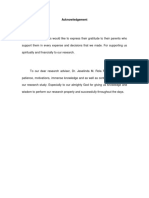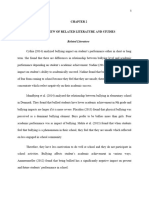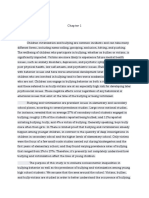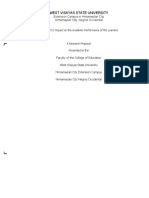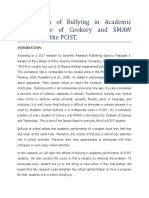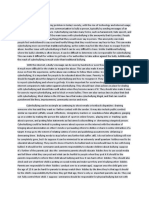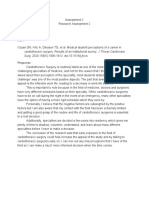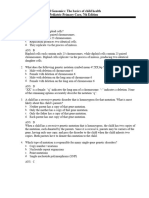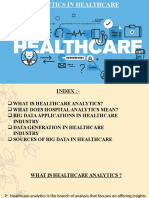Cyberbullying
Cyberbullying
Uploaded by
QUINTILLA ALEXXA YNA MARICopyright:
Available Formats
Cyberbullying
Cyberbullying
Uploaded by
QUINTILLA ALEXXA YNA MARICopyright
Available Formats
Share this document
Did you find this document useful?
Is this content inappropriate?
Copyright:
Available Formats
Cyberbullying
Cyberbullying
Uploaded by
QUINTILLA ALEXXA YNA MARICopyright:
Available Formats
RESEARCH TOPIC: HOW TO PREVENT CYBERBULLYING ON
TEENAGERS
REVIEW OF RELATED LITERATURE AND REVIEW OF RELATED
STUDIES
FOREIGN LITERATURE
Bullying that occurs over digital devices such as cell phones, laptops, and tablets
is known as cyberbullying. Cyberbullying can take place offline in social media,
forums, or gaming where people can watch, participate in, or share content, or online
in social media, forums, or gaming where people can view, participate in, or share
content. Sending, uploading, or spreading unpleasant, harmful, misleading, or nasty
content about someone else is considered cyberbullying. It can involve
embarrassment or humiliation caused by sharing intimate or private information about
another individual. Cyberbullying can sometimes cross the line into illegal or criminal
action. Cyberbullying has been connected to adolescent victims' social, physical, and
psychological issues, but no research has looked into the function of emotional
intelligence in preventing the unpleasant symptoms associated with cyberbullying
victimization. (Extremera, N, et al 2018)
Since online bullying is frequently anonymous or difficult to track, it can be
especially harmful and disturbing. It's extremely difficult to manage, and the victim
has no idea how many individuals (perhaps hundreds) have seen the messages or
posts. When they check their phone or computer, they might be tormented
indefinitely. (Sleglova, V, et al 2011) . Since the bully does not have to contact his or
her target in person, online bullying and harassment can be easier to commit than
other forms of bullying. When confronted with such a distressing scenario, which is
often difficult to escape, victims of cyberbullying exhibit a wide range of emotions.
According to Stopbullying.gov (2017), victims' reactions to internet harassment,
concentrating on the occurrence of various emotions and the victims' subsequent
behavior in response to cyber harassment. Anger, despair, worry, shame, sobbing,
fear, and self-blame were among the emotions experienced. Other negative
consequences were observed, including decreased concentration and school grades, as
well as departure from school. Individuals' comments, images, postings, and content
uploaded on social media and digital forums are frequently viewed by strangers as
well as acquaintances. An individual's internet content, both personal and any bad,
harsh, or cruel content, establishes a kind of permanent public record of their beliefs,
actions, and behavior. This public record can be regarded of as an online reputation
that can be accessed by schools, employers, universities, groups, and others that are
currently or in the future conducting research on an individual. Not just the individual
being bullied, but also those who bully others, can have their online reputations
harmed by cyberbullying. (Public Safety Canada, 2018)
FOREIGN STUDIES
According to the study of Extremera, N. et al (2018) entitled “Cyberbullying
Victimization, Self-Esteem and Suicidal Ideation in Adolescence: Does Emotional
Intelligence Play a Buffering Role?”, Despite these flaws, our findings add to the
growing body of data that EI should be considered a personal resource related to the
negative symptoms of cyberbullying victimization. Our findings add to the theoretical
literature on cyberbullying and its negative consequences in adolescence, but they
also have the potential to be used to develop school-based, integrated bullying
prevention programs aimed at improving adolescents' emotional abilities in order to
protect against, or at least mitigate, the negative consequences of being a victim of
cyberbullying.
Based on the research study entitled “Current Perspectives: The Impact Of
Cyberbullying On Adolescent Health” by Charisse L. Nixon (2014), Cyberbullying
victimization and perpetration have been shown to have a major negative influence on
adolescents' health in studies. Indeed, the research presented here suggests that
cyberbullying is a rising international public health concern linked to major mental
health issues, having a considerable influence on teenagers' despair, anxiety, self-
esteem, emotional distress, substance use, and suicidal conduct. Furthermore,
cyberbullying is linked to physical health concerns in teens. When dealing with
teenage health issues like depression, substance abuse, suicide ideation, and somatic
concerns, careful investigation into cyberbullying experiences is necessary. Routine
screening approaches can be created to assist in identifying the harm caused by
cyberbullying and to aid adolescents in recovering from the trauma connected with it.
Finally, the findings of the study point to a critical need for comprehensive, school-
based cyberbullying prevention and intervention programs. Cyberbullying education
could be integrated into school curriculums and the general society, for example, by
involving adolescents in intellectual debates and community service.
Based on the study of Kalliope Athanasiou, Eirini Melegkovits, Elisabeth K.
Andrie, Charalampos Magoulas, Chara K. Tzavara, Clive Richardson, Donald
Greydanus, Maria Tsolia & Artemis K. Tsitsika (2018) entitled “Cross-National
Aspects Of Cyberbullying Victimization Among 14–17-Year-Old Adolescents Across
Seven European Countries”, Romania had the greatest percentage of cyber-
victimization (37.3%), while Spain had the lowest (13.3 percent ). The findings of
multiple logistic regression studies varied by country. Cyberbullying victimization
was linked to SNS use in Romania, Poland, and Germany, but only in Romania was
Internet use linked to a higher risk of cybervictimization. In all nations studied,
cybervictimization was linked to more internalizing and externalizing behavior
problems, with the exception of Romania. Cyberbullying is a persistent problem that
is influenced by country-specific socio-demographic characteristics as well as various
patterns of contemporary Internet use and development. Preventive strategies should
focus on the constant link between cybervictimization and internalizing and
externalizing challenges, as well as the incorporation of Internet communication
technology education in educational environments.
LOCAL LITERATURE
Cyberbullying is when someone uses technology to harass, threaten, shame, or
harass someone else. Posting personal information, photos, or videos with the intent
to harm or embarrass another individual is also prohibited. (Ben-Joseph, E. 2018)
Photos, texts, or pages that are not taken down despite being asked to do so constitute
cyberbullying. To put it another way, it's anything that's posted on the internet with
the intent of injuring, harassing, or upsetting another person. Online bullying, like
traditional forms of bullying, can sometimes result in catastrophic long-term
consequences. The stress of being sad or afraid all of the time can affect one's mood,
energy level, sleep, and eating. It can also make someone feel jittery, anxious, or
depressed.
Cyberbullying can exacerbate depression or anxiety in people who are already
sad or anxious. It isn't just the individual who is bullied that suffers. Cyberbullies may
face severe consequences. More and more schools and after-school programs are
developing cyberbullying response mechanisms. Bullies may be kicked from sports
teams or suspended from school. (Santiago, M. 2015) As cyberbullying has grown
more common as a result of technological advancements, many states have amended
their laws to include or reference cyberbullying offenses. Schools may act in
accordance with the law or in accordance with municipal or school policies that allow
them to penalize students or take other actions. Bullying is also addressed in some
cities if it has an impact on school achievement. You can read about each state's laws
and policies, including whether or not they include cyberbullying.
According to Elena Pearl Ben-Joseph (2018) ,victims of cyberbullying have few
options for defending themselves. There are no teachers or parents there to notice
what is going on and intervene to stop it. Cyberbullying can also be anonymous,
leaving the victim with few options for reporting the attacker to someone in authority.
And, by leveraging social media platforms, cyberbullying can expose bullying
occurrences to hundreds, if not thousands, of people in a short period of time. The
bully can simply start a new account if the victim knows who the abuser is and
chooses to block them on social media. They can also send a text, send a message, or
utilize a friend's account. Today's children are incredibly clever and technologically
sophisticated.
LOCAL STUDIES
According to Emmanuel Patrick Jeremiah C. Fernandez (2018) in his study
entitled “Falling Into the Online Shaming Trap: Understanding and Considering
Perspectives in Online Shaming”, Technology has played a significant role in our
lives. It provided opportunity for us to simplify our lives. It gave birth to the internet,
which has served as a primary means of communication as well as a means of sharing
information and learning from others. Regrettably, it also encouraged bad behaviors
like online shaming. If we want to reap the benefits of online shaming, we need to
keep it under control. We should always look for the advantages in each of the
concepts and ideas we obtain from the internet. Negativity must be eradicated.
Instead, we should endeavor to comprehend and accept the other person's point of
view, even if it differs from ours.
Based on a study entitled “Implementation of anti-cyberbullying laws among the
youth sector in Cainta, Rizal.” by Philip Earl Santos (2017), Due to the sheer
widespread use of the Internet by teenagers, cyberbullying is on the rise. According to
Pew Internet (2008), 89 percent of boys and 95 percent of girls have written or
received email, 56 percent of girls and 55 percent of boys have visited chat rooms,
and 75 percent of teenagers have texted their pals for 30 to 60 minutes. Interviews and
focus group discussions were used to perform a phenomenological qualitative study
on grade school adolescents. Individual interviews were conducted to evaluate the
disinhibition, dissociative anonymity, and social dominance theories, revealing
deindividuation and desensitization traits in adolescent bullies.
Based on the study of Bilag Sionny B., Cadena Christian B., Capdos Marie
Joy M., Chalmas Charies S., Dawiguey Joshlee S., Gimarangan Joglenn I., Movilla
Bennex Anne M., Obfan Randy T., Toyoken Annabelle A., Vicente Jezreel B. (2021)
entitled “Case study on cyber-bullying among criminal justice and public safety
students of university of Baguio”, It was discovered that among criminology students,
cyber-bullying takes the form of posting photos that degrade or humiliate the victim
in various ways, as well as writing nasty remarks. The victims of cyberbullying suffer
from low self-esteem and shyness as a result of the bullying. Their academic
performance suffers as a result of their diminished confidence, which leads to
absenteeism. Family members are socially affected as well, and they feel ashamed in
the community. Victims of cyberbullying overcome their experiences as a result of
church-related activities, according to their coping mechanisms. Despite their ordeals,
the cyber-bully victims grew stronger and more determined to move on. Others
shifted their focus.
REFERENCES
Athanasiou, Kalliope, Eirini Melegkovits, Elisabeth K. Andrie, Charalampos
Magoulas, Chara K. Tzavara, Clive Richardson, Donald Greydanus, Maria Tsolia, and
Artemis K. Tsitsika. “Cross-national Aspects Of Cyberbullying Victimization Among
14–17-year-old Adolescents Across Seven European Countries - BMC Public
Health.” BMC Public Health. bmcpublichealth.biomedcentral.com, July 10, 2018.
https://bmcpublichealth.biomedcentral.com/articles/10.1186/s12889-018-5682-4.
“Case Study On Cyber-bullying Among Criminal Justice And Public Safety Students
Of University Of Baguio-Indian Journals.” Case study on cyber-bullying among
criminal justice and public safety students of university of Baguio-Indian Journals.
www.indianjournals.com, January 1, 2020. https://www.indianjournals.com/ijor.aspx?
target=ijor:ijarmss&volume=9&issue=1&article=012.
“Current Perspectives: the Impact Of Cyberbullying On Adolescent Health.” PubMed
Central (PMC). www.ncbi.nlm.nih.gov, January 1, 2014.
https://www.ncbi.nlm.nih.gov/pmc/articles/PMC4126576/.
“Cyberbullying (for Teens) - Nemours KidsHealth.” Cyberbullying (for Teens) -
Nemours KidsHealth. kidshealth.org, April 1, 2018.
https://kidshealth.org/en/teens/cyberbullying.html.
Extremera, Natalio, Cirenia Quintana-Orts, Sergio Mérida-López, and Lourdes Rey.
“Cyberbullying Victimization, Self-Esteem And Suicidal Ideation In Adolescence:
Does Emotional Intelligence Play a Buffering Role?.” Frontiers. www.frontiersin.org,
January 1, 2001. https://www.frontiersin.org/articles/10.3389/fpsyg.2018.00367/full.
Maribbay Santos, Philip Earl. “DSpace At College Of Arts And Sciences:
Implementation Of Anti-cyberbullying Laws Among the Youth Sector In Cainta,
Rizal..” DSpace at College of Arts and Sciences: Implementation of anti-
cyberbullying laws among the youth sector in Cainta, Rizal.. dspace.cas.upm.edu.ph,
January 1, 2017. http://dspace.cas.upm.edu.ph/jspui/handle/123456789/718.
“May 18, 2018 – Arguments Of (tired) College Students.” Arguments of (tired)
College Students. earlymorningswithr04.wordpress.com, May 18, 2018.
https://earlymorningswithr04.wordpress.com/2018/05/18/.
Šléglová, Veronika, and Alena Cerna. “Cyberbullying In Adolescent Victims:
Perception And Coping | Šléglová | Cyberpsychology: Journal Of Psychosocial
Research On Cyberspace.” Cyberbullying in Adolescent Victims: Perception and
Coping | Šléglová | Cyberpsychology: Journal of Psychosocial Research on
Cyberspace. cyberpsychology.eu, December 1, 2011.
https://cyberpsychology.eu/article/view/4248/3294.
“What Are the Effects Of Cyberbullying? | Kaspersky.” usa.kaspersky.com.
usa.kaspersky.com, August 9, 2021.
https://usa.kaspersky.com/resource-center/preemptive-safety/cyberbullying-effects.
What Is Cyberbullying | StopBullying.gov.” StopBullying.gov.
www.stopbullying.gov, September 24, 2019.
https://www.stopbullying.gov/cyberbullying/what-is-it.
You might also like
- Cyberbullying Annotated Bibliography FinalDocument8 pagesCyberbullying Annotated Bibliography Finalapi-258925897100% (3)
- Neogen Food Allergen Handbook Testing Guide For Food AllergensDocument18 pagesNeogen Food Allergen Handbook Testing Guide For Food AllergensAndreiNo ratings yet
- Cyberbullying An OverviewDocument13 pagesCyberbullying An OverviewantonyNo ratings yet
- Eradicating Cyber Bullying: Through Online Training, Reporting & Tracking SystemFrom EverandEradicating Cyber Bullying: Through Online Training, Reporting & Tracking SystemRating: 5 out of 5 stars5/5 (1)
- CyberbullyingDocument33 pagesCyberbullyingMikhail DayagdagNo ratings yet
- A Review of The Literature On BullyingDocument20 pagesA Review of The Literature On BullyingRaluca AlexandraNo ratings yet
- Chapter 2Document4 pagesChapter 2Ela Araojo Guevarra100% (1)
- CyberbullyingDocument13 pagesCyberbullyingKylex Dee100% (2)
- Research Paper..Document25 pagesResearch Paper..ululkawNo ratings yet
- Cyberbullying: What Every Parent Should Know About Electronic BullyingFrom EverandCyberbullying: What Every Parent Should Know About Electronic BullyingRating: 3.5 out of 5 stars3.5/5 (3)
- The Impact of Cyberbullying To The Mental Health of The Grade 12 AbmDocument19 pagesThe Impact of Cyberbullying To The Mental Health of The Grade 12 AbmSerene Riego100% (1)
- Negative Effects of Cyber Bullying To StudentDocument2 pagesNegative Effects of Cyber Bullying To StudentJamesan Pasanting Beloy100% (1)
- Cyberbullying and Self-EsteemDocument9 pagesCyberbullying and Self-EsteemDantrsNo ratings yet
- Final PR1Document32 pagesFinal PR1Dearly Wurtzbach0% (1)
- Research About Cyberbullying Research About CyberbullyingDocument32 pagesResearch About Cyberbullying Research About Cyberbullyingalyza de joseNo ratings yet
- Chapter II VinceDocument8 pagesChapter II VinceDianne RuizNo ratings yet
- Curbing Cyberbullying Among Students: A Comparative Analysis of Existing Laws Among Selected Asean CountriesDocument21 pagesCurbing Cyberbullying Among Students: A Comparative Analysis of Existing Laws Among Selected Asean CountriesGlobal Research and Development ServicesNo ratings yet
- Synthesis PaperDocument10 pagesSynthesis Paperapi-359257144No ratings yet
- The United Methodist Church Ecumenical Christian College Junior High School Department S.Y 2019-2020Document8 pagesThe United Methodist Church Ecumenical Christian College Junior High School Department S.Y 2019-2020Ethiopia TrinityNo ratings yet
- Philippine Christian UniversityDocument50 pagesPhilippine Christian UniversityChristian Martinez100% (2)
- Final Revisiono of CyberbullyingDocument10 pagesFinal Revisiono of CyberbullyingRaymond Retreta100% (1)
- BullyingDocument8 pagesBullyingdiether jay martinNo ratings yet
- Chapter 2Document9 pagesChapter 2Sugie BarreraNo ratings yet
- Cyberbullying: A Study To Find Out How Online Bullying Affects The Academic Performance of Grade 12 StudentsDocument12 pagesCyberbullying: A Study To Find Out How Online Bullying Affects The Academic Performance of Grade 12 StudentsShen RondinaNo ratings yet
- Cyberbullying PaperDocument8 pagesCyberbullying Papercourtneymvoss100% (2)
- Junior High School Students' Perception About Social Media As A Place of Bullying.Document6 pagesJunior High School Students' Perception About Social Media As A Place of Bullying.Fed RamosNo ratings yet
- PR2Document14 pagesPR2Knight MonteroNo ratings yet
- Research Paper (Bullying)Document7 pagesResearch Paper (Bullying)VanissaNo ratings yet
- The Effects o Bullying To The Mental HealthDocument17 pagesThe Effects o Bullying To The Mental HealthShena Mae SamarroNo ratings yet
- Prevalence of Bullying in Grade 10 Junior High School Chapter 1Document16 pagesPrevalence of Bullying in Grade 10 Junior High School Chapter 1HELEN TAANGNo ratings yet
- Effect of BullyingDocument11 pagesEffect of BullyingAnonymous 2ch6hSNo ratings yet
- West Visayas State University: Extension Campus in Himamaylan City Himamaylan City, Negros OccidentalDocument33 pagesWest Visayas State University: Extension Campus in Himamaylan City Himamaylan City, Negros OccidentalMARLON TABACULDENo ratings yet
- Chapter 3Document3 pagesChapter 3Jericho PauloNo ratings yet
- High School BullyingDocument24 pagesHigh School BullyingtoxictouchNo ratings yet
- The Effects of Social Media On CyberbullyingDocument29 pagesThe Effects of Social Media On CyberbullyingChristian Jade SamsonNo ratings yet
- ResearchDocument14 pagesResearchIan Dikit NicolasNo ratings yet
- Cyberbullying: A Literature Review: January 2009Document71 pagesCyberbullying: A Literature Review: January 2009Jhiezle Villanueva Sanchez100% (1)
- Cyber Bullying and Academic Performance of Grade VII Student1Document19 pagesCyber Bullying and Academic Performance of Grade VII Student1lloyd olimbaNo ratings yet
- BULLYING FinalDocument50 pagesBULLYING Finalagerestrictions0001100% (1)
- Q1. What Is The Most Common Cyberbullying Case You've Witnessed?Document2 pagesQ1. What Is The Most Common Cyberbullying Case You've Witnessed?Yna ForondaNo ratings yet
- Castillo, Princess (EAPP TASK 3) Position Paper CyberbullyingDocument1 pageCastillo, Princess (EAPP TASK 3) Position Paper CyberbullyingSaoirse Leviste0% (1)
- Ready To Print ThesisDocument41 pagesReady To Print ThesisKatrina Sarong AmotoNo ratings yet
- Chapter 12345 Final VinceDocument51 pagesChapter 12345 Final VinceDianne RuizNo ratings yet
- Bullying ArticleDocument6 pagesBullying Articlebarn5094100% (1)
- Effects of Cyber Bullying and Discrimination in The Students of New Cabalan National High SchoolDocument10 pagesEffects of Cyber Bullying and Discrimination in The Students of New Cabalan National High SchoolWilbert VenzonNo ratings yet
- ResearchDocument2 pagesResearchmira lorraine malapitanNo ratings yet
- Impact of CyberbullyingDocument37 pagesImpact of CyberbullyingUswatun Hasanah100% (1)
- The Effects of Bullying in Academic Performance of Cookery and SMAW Students in The PCISTDocument2 pagesThe Effects of Bullying in Academic Performance of Cookery and SMAW Students in The PCISTjohaira caparida100% (1)
- Group 3 Cyberbullying Copy 1Document38 pagesGroup 3 Cyberbullying Copy 1pamela de leonNo ratings yet
- The Impact of Social Media On Self-Esteem Among AdolescentsDocument1 pageThe Impact of Social Media On Self-Esteem Among AdolescentspkmcNo ratings yet
- Glossary of Cyberbullying TermsDocument1 pageGlossary of Cyberbullying TermsVevendi 2000100% (1)
- The Impact of Bullying On The Adolescence Stage of A Student in Saint Mary Magdalene COLLEGES OF LAGUNA S.Y. 2019-2020Document22 pagesThe Impact of Bullying On The Adolescence Stage of A Student in Saint Mary Magdalene COLLEGES OF LAGUNA S.Y. 2019-2020Kyla BañezNo ratings yet
- Bullying: The Impact of Bullying in The Growth of The Students in Yllana Bay View College Grade 11 Students of Morning ClassDocument4 pagesBullying: The Impact of Bullying in The Growth of The Students in Yllana Bay View College Grade 11 Students of Morning ClassCristine Joyce Campos ParojinogNo ratings yet
- Essay About CyberbullyingDocument2 pagesEssay About CyberbullyingMarianne BalitaNo ratings yet
- Cyberbullying: Quantitative ResearchDocument20 pagesCyberbullying: Quantitative ResearchDave Evans50% (2)
- Chapter 1 The Effects of Cyberbullying To The Academic Performance of The Grade 12 Senior High School Students of AsmnhsDocument8 pagesChapter 1 The Effects of Cyberbullying To The Academic Performance of The Grade 12 Senior High School Students of AsmnhsMark Dave Aborita MorcoNo ratings yet
- Cybercrime Awareness Among Senior High School StudentsDocument17 pagesCybercrime Awareness Among Senior High School StudentsMJBAS JournalNo ratings yet
- Effects of Verbal and Physical Bullying Among The Students of Grade 7 4Document16 pagesEffects of Verbal and Physical Bullying Among The Students of Grade 7 4Chezka Romeo OrolazaNo ratings yet
- A. Problem and It's BackgroundDocument5 pagesA. Problem and It's Backgroundarisu100% (1)
- Alarmed Problem – Pregnancy in The Teenage: A Serious Crime and TragedyFrom EverandAlarmed Problem – Pregnancy in The Teenage: A Serious Crime and TragedyNo ratings yet
- Eats BobaliciousDocument7 pagesEats BobaliciousQUINTILLA ALEXXA YNA MARINo ratings yet
- Argumentative EssayDocument2 pagesArgumentative EssayQUINTILLA ALEXXA YNA MARINo ratings yet
- Cheers To The Next ChapterDocument1 pageCheers To The Next ChapterQUINTILLA ALEXXA YNA MARINo ratings yet
- Dear Younger Version MeDocument1 pageDear Younger Version MeQUINTILLA ALEXXA YNA MARINo ratings yet
- DepressionDocument2 pagesDepressionQUINTILLA ALEXXA YNA MARINo ratings yet
- Skills For Nursing Leaders and ManagersDocument5 pagesSkills For Nursing Leaders and ManagersRosa MiaNo ratings yet
- 18-11-15 GP Presentation CamdenNBDocument17 pages18-11-15 GP Presentation CamdenNBMa. Soledad RodriguezNo ratings yet
- Royal InteriorsDocument19 pagesRoyal InteriorsbhuvanaNo ratings yet
- First Lecture - Nursing ProcessDocument57 pagesFirst Lecture - Nursing ProcessNoor MajaliNo ratings yet
- Arihan Gupta - Research Assessment 2Document2 pagesArihan Gupta - Research Assessment 2api-529369011No ratings yet
- BANDAGINGDocument2 pagesBANDAGINGRomm JacobNo ratings yet
- Tiếng anh (chương trình mới) .Document13 pagesTiếng anh (chương trình mới) .tthnhi2202No ratings yet
- Perdev - Module 9Document9 pagesPerdev - Module 9April Rose CortesNo ratings yet
- New CBT Questions For Year 10 First Term ExamDocument10 pagesNew CBT Questions For Year 10 First Term ExamBridget OmonikeNo ratings yet
- Chapter 03: Genetic and Genomics: The Basics of Child Health Garzon Maaks: Burns' Pediatric Primary Care, 7th EditionDocument3 pagesChapter 03: Genetic and Genomics: The Basics of Child Health Garzon Maaks: Burns' Pediatric Primary Care, 7th EditionHelen Ugochukwu100% (1)
- The Effectiveness of Compassion-Focused TherapyDocument14 pagesThe Effectiveness of Compassion-Focused TherapyAfrodite MouNo ratings yet
- Swingo 150Document21 pagesSwingo 150Luís RolaNo ratings yet
- CH 02 - Skills For Healthy LifeDocument42 pagesCH 02 - Skills For Healthy LifeCollins OchiengNo ratings yet
- BA PresentationDocument23 pagesBA PresentationRajpurohit Jigar SinghNo ratings yet
- Jadia-Gador Group of CompaniesDocument4 pagesJadia-Gador Group of CompaniesLea SalamanesNo ratings yet
- Pe 3 Module Athletics ArnisDocument97 pagesPe 3 Module Athletics ArnisJUSTINE Angeles100% (1)
- BPIN ComplianceDocument4 pagesBPIN CompliancejustewesleyNo ratings yet
- Pak Orthocon Suppl - GPDocument110 pagesPak Orthocon Suppl - GPhishamkhan002No ratings yet
- DLP Opinion Marking Signals CASTUERAS MANUELDocument9 pagesDLP Opinion Marking Signals CASTUERAS MANUELJessa MolinaNo ratings yet
- Interpersonal Communication Notes PDFDocument1 pageInterpersonal Communication Notes PDFAidan TranNo ratings yet
- Recent Developments in Dough-Based Bakery Products: A Mini ReviewDocument6 pagesRecent Developments in Dough-Based Bakery Products: A Mini Reviewamir ShehzadNo ratings yet
- A topical approach to life-span development 9th Edition John W. Santrock All Chapters Instant DownloadDocument47 pagesA topical approach to life-span development 9th Edition John W. Santrock All Chapters Instant Downloadnatitapirak100% (1)
- Pre Season We 2.0Document22 pagesPre Season We 2.0Danielle MayoNo ratings yet
- MODULE 2 - Freud PsychoanalysisDocument8 pagesMODULE 2 - Freud PsychoanalysisLAGRANA, MA. ANGELICA A.No ratings yet
- Ignite Weekend Parental Consent FormDocument6 pagesIgnite Weekend Parental Consent FormStu FarrowNo ratings yet
- Sample Review Matrix On The Use of Acupuncture For Treating Chronic Lower Back PainDocument3 pagesSample Review Matrix On The Use of Acupuncture For Treating Chronic Lower Back PainJonas SanchesNo ratings yet
- Child Abuse AND Battered Child SyndromeDocument90 pagesChild Abuse AND Battered Child SyndromeAmy Lalringhluani ChhakchhuakNo ratings yet
- Chapter 7: - Analysis of HR Policies and Ethical Code of Conduct Between Tcs and AccentureDocument20 pagesChapter 7: - Analysis of HR Policies and Ethical Code of Conduct Between Tcs and AccentureJob PlacementNo ratings yet
- ELVi Pro User ManualDocument29 pagesELVi Pro User Manualalamsyah hattaNo ratings yet














